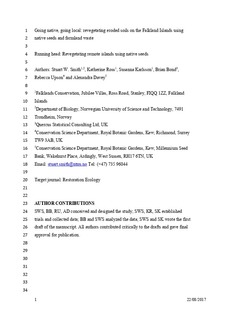| dc.description.abstract | Remote island ecosystems are vulnerable to human disturbance and habitat destruction, yet they often have limited capacity to revegetate degraded habitats, especially with native species. To revegetate degraded island habitats, practitioners often rely on importing non-native species, thereby increasing the number of introduced species on islands. In this study, we investigated the effectiveness of sowing wild collected native seeds and locally sourced treatments for revegetating different eroded soil types (clay, peat, and sand) across the Falkland Islands. A seed mixture of 15 native species was sown with different supportive treatments (sheep dung, sheep dags [woolly off-cuts], and geotextile matting [coir]) and their combinations. After 1 year, native seeds provided up to 70% plant cover and accrued 1.98 kg/m2 in biomass. Three key native species Elymus magellanicus, Poa flabellata, and Poa alopecurus occurred in 64, 50, and 50% of all sown plots. However, supportive treatments equally facilitated the colonization and establishment of non-native species. At the same time, there was no difference in native plant cover and biomass across different treatments or soil types, although in the absence of supportive treatments there was little to no revegetation. Thus, locally sourced treatments (i.e. sheep dung and dags) may provide an equally effective but low-cost alternative to imported treatments (i.e. geotextiles). We further discuss challenges of integrating revegetation using native seeds and livestock grazing on the Falkland Islands. Our study demonstrates that native species and local treatments can provide a rapid approach to revegetating degraded island habitats. | nb_NO |
